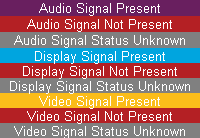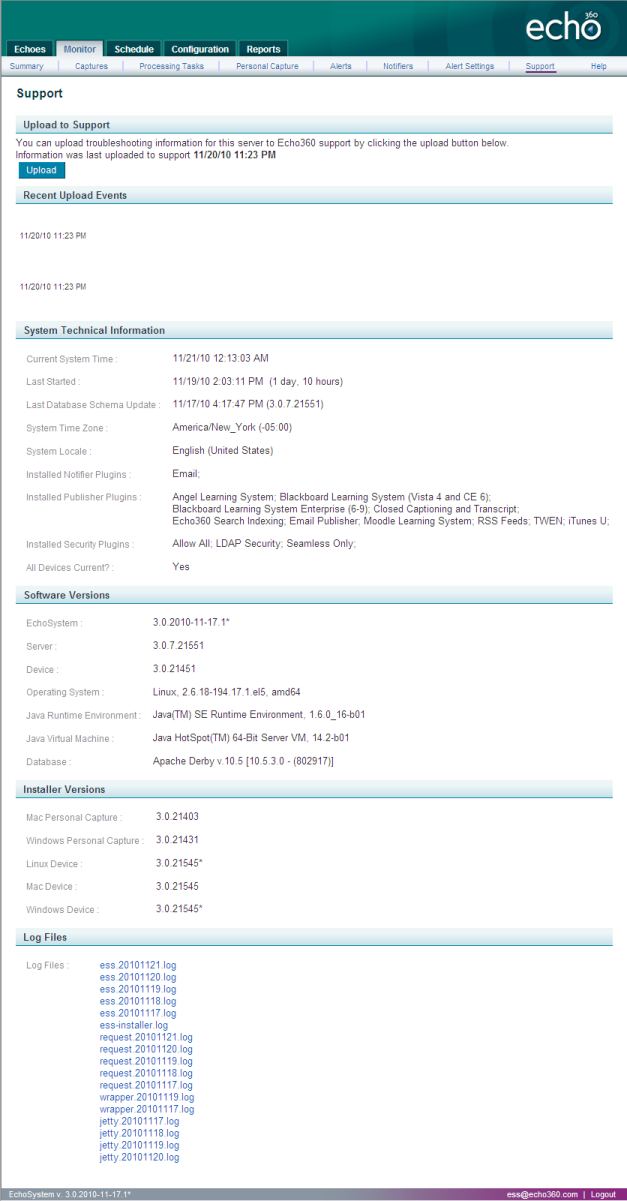...
| Insert excerpt | ||||||||
|---|---|---|---|---|---|---|---|---|
|
- Navigate to Monitor > Summary. The Summary tab appears.
View the Recent Captures area below the summary statistics, shown in the below figure.
All recent captures appear on one of four tabs: Scheduled, Capturing, Processing, or Completed, as defined in the table below.
Capture State
Definition
Scheduled
A capture that has been scheduled for later today.
Capturing
A lecture that is currently being captured.
Processing
A capture or media import that is being processed and packaged for use.
Completed
A capture that has completed processing and has been published to the selected publisher(s).
- Find the capture you want to monitor. You can do that in either of the following ways.
- Search for a capture that meets the search criteria you enter.
- Browse thecapturesby state by clicking the relevant tab as described in the table above.
Review the status of the capture. The following table explains each element of the capture's status.
Status Element
Definition
Time
Start and end time of the capture
Course
The Course Identifier associated with a course in the system
Room
Physical location where the capture occurs
Capture Status
Displays the status of the capture of the lecture or external media import. Options are Waiting, Uploading Files, Capturing, Succeeded, Failed, and Missed.
A capture that is Failed or Missed will be listed for seven days, then deleted.Info title Missed Captures A missed capture is a scheduled capture that did not start capturing. A capture might be missed if there is not a device in the room, if the scheduled capture was not transmitted to the device in time for the capture to actually start, or a power outage occurred. The System Administrator can troubleshoot a missed capture by monitoring the device and confirming that it is licensed.
Source
Shows the status of the video, display, and audio signals associated with the capture. The following image explains the color coding of the signal status.
Info The source signal graph only shows the status of the latest 60-minute block of the capture, in one-minute intervals.
Streaming If a currently capturing item is a live webcast, the Streaming column provides an icon to indicate whether the expected input is streaming properly, and provides a Monitor link that allows you to open the student view of the webcast to see what is being broadcast in real-time. Processing Status
Displays the status of the processing of the capture, which involves packaging the capture into a form that a student, for example, can experience. Options are Succeeded, Failed, License Expired, or Cancelled.
Info title About the Succeeded Status It is possible for a capture's processing status to display Succeeded even when the source signal graph shows areas of problems with a source signal. The processing status complements the source signal graph. Succeeded indicates that some signal was successfully captured. Problems in the source signal highlight portions of the captured media that may not have captured the desired content. For example, if the Audio Signal shows as Not Present, perhaps because the microphone was unplugged, the capture's processing status would show as Succeeded but the captured media may have an audio dropout.
Progress
Displays the percent complete of the processing step.
Elapsed
Time in hours, seconds, and minutes since processing began.
Note title Elapsed Processing Times Please be aware that in situations where jobs are processed back-to-back, the Elapsed column on the Monitor >Summary page will report incorrect values.
Publishing
If the capture is scheduled to be published, this field shows the name of each publisher (such as RSS or Email) and its status: Success ( ), Pending ( ), Retry ( ), and Failure ( ).
Alerts
Number of times this capture has raised a publishing alert.
Info title Sort the list of captures You can sort the list of captures for a selected capture state tab by clicking the column name.
...
| Insert excerpt | ||||||||
|---|---|---|---|---|---|---|---|---|
|
View the status of all captures, including Echoes (lecture captures) and external media imports, on the Captures tab. Click any capture name to view its details.
...
| Insert excerpt | ||||||||
|---|---|---|---|---|---|---|---|---|
|
On the Processing page, you can see the captures currently being processed and in the queue for processing. In addition to viewing the details of the task in either list, you can prioritize (raise or lower the priority in the list) or cancel the tasks for the ESS in the Queued to be Processed list.
...
| Insert excerpt | ||||||||
|---|---|---|---|---|---|---|---|---|
|
This tab lists computers with Personal Capture that have connected to the ESS.
...
| Insert excerpt | ||||||||
|---|---|---|---|---|---|---|---|---|
|
You can receive alerts that apply to ESS as a whole or to a specific capture. They show if something out of the ordinary has happened on your EchoSystem. For example, if the capture was not licensed or your ESS is out of disk space, you can receive an alert.
...
| Insert excerpt | ||||||||
|---|---|---|---|---|---|---|---|---|
|
You can set up EchoSystem to send a notifier e-mail if a system alert occurs. Receiving these notifications helps you address potential problems quickly, thereby maintaining system up time. You can view these emails as well as add, edit, and delete them.
...
| Insert excerpt | ||||||||
|---|---|---|---|---|---|---|---|---|
|
You can view all alerts configured and specify which alerts selected users should receive. When the administrator configures an alert, he or she subscribes to it on behalf of a selected user role. For example, when triggering events occur, an alert about them is sent only to people with selected roles such as A/V Technician, Server Administrator, and Academic Staff.
...
| Insert excerpt | ||||||||
|---|---|---|---|---|---|---|---|---|
|
When you need support, navigate to Monitor > Support and share the details there about your ESS to support personnel. You can even upload this information directly to support personnel by clicking the Upload button at the top of the page. Click the logs at the bottom of the page to get details about all recent capture and processing tasks.
...
| Insert excerpt | ||||||||
|---|---|---|---|---|---|---|---|---|
|
Overview
Log files (except for the ess-installer.log) show detailed daily operations by component. You might be asked to send a log file to Technical Support or to look at one while talking with a Technical Support engineer.
...






